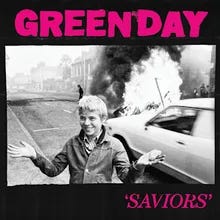Criticism, nostalgia and me
The fate of the record review in modern times and a look at new albums from two legacy acts that make me feel old: Green Day and Sleater-Kinney
It has been a difficult time for writers of late. Sports Illustrated just laid off its entire staff, the Los Angeles Times laid off many people – including, it seems, the entire team behind the Times book coverage — and Pitchfork laid off several writers and editors and is about to be folded into GQ.
Pitchfork was the one that drew most of my attention. Though I haven't spent much time with the site in the past decade or so — coinciding with its shift away from writing about things I like to listen to and toward more pop/mainstream fare — I spent a lot of time perusing its reviews and news from its inception through the end of the aughts. It had an outsized influence on certain segments of our culture, shining a bright light on artists deserving and not, and helped to shape the way a generation thinks about and appreciates music for good or ill.
One aside: Pitchfork is best known for the numbering system of its reviews. Albums are rated from 0.0 to 10.0. I don't mind it, save for when reviewers deploy one of those absolutes. I can’t imagine ever giving a 0.0 or a 10.0, because that means either there is zero merit to an album, or even more improbable, that it is perfect. I try to evaluate creative work based as much on the artist's intent as on my feelings toward the piece in question. As such, there is always something of worth, even if I hate it.
The only sure thing to come from the seeming dismantling of Pitchfork is that this Substack will soon be joined by those of many displaced writers seeking to control their own destinies. I would love to keep up with the best of those writers and the dozens of others who use Substack, but if I look at it reasonably, I know that will be the case for very few. I simply don't have the time or budget to follow dozens of them. If only we could find a way to aggregate the work of those writers in one place and allow people to pay one fee to access it…
Oh well, maybe someday. In the meantime, as is the case with so many other limitless buffets of content — streaming television and all-encompassing music streaming services among them — the ability of anyone to start a publication means we are paralyzed by choice. Too much content and no moderation means we'll miss more than ever before.
Awkward segue alert: At least you won't miss this one, because you have subscribed, right? Doing so has always been free, and for the foreseeable future it will remain so. However, I figure it is silly to post to a platform that provides an easy way for people to pay for the privilege of reading and not give them the choice. So, I have created a paid option for My Impression Now. For now, everything will be the same, free or paid, though if you do choose to pay you'll certainly motivate me to post more regularly. Over the coming year I may devise ways to expand certain posts or offer special content for anyone benevolent (foolish? Benevolently foolish?) enough to pay. My goal has always been to use whatever funds I secure to pay for other Substacks, so if you do choose to pay, you'll be participating in an odd, upside down Ponzi scheme that will support other writers.
Saviors and Little Rope
Or, more words about Green Day than I ever would have imagined I could conjure, plus Sleater-Kinney!


Two new albums from acts I listened to a lot in my 20s have me thinking about how we respond to artists as they evolve. Both new albums — Green Day's Saviors and Sleater-Kinney's Little Rope — did little for me despite obvious nods to the work they were doing when I was paying attention.
For Green Day, that was Dookie, the now 30-year-old megaseller that rarely left my cassette player the summer of 1994. I was grinding my way through what were thankfully the final months of a year-long exile at the newspaper in Ottumwa, and Dookie's mix of hooks, loud guitars and snotty attitude was the perfect balm. I found things to like in each of the next few albums (particularly Nimrod), but pretty much lost the plot after 2004's American Idiot faded from the airwaves.
With Sleater-Kinney, 1997's Dig Me Out was a revelation, a raw declaration of intent that wasn't beholden to usual standards. Two guitars and a ferocious drummer were barely enough to contain the frantic yelp of vocalist Corin Tucker, and it made me an instant fan. The next two LPs sharpened and shaped that sound, but by the time of later albums like One Beat and The Woods, I had largely lost interest, feeling more admiration than ardor for the trio's sound.
Fast forward a couple of decades, and each has a new album that is positioned as a comeback of sorts. Then again, 30 years into a career, aren't they all? Green Day's latest is promoted as a sort of conclusion to a spiritual trilogy with Dookie and American Idiot, and it is certainly clear the same band made all three albums. But the fire on that flaming bag of dogshit on the front stoop has been extinguished. These are guys in their 50s, and no amount of nostalgic over-shoulder glances can make these songs sound like anything other than product. It's very well-made product, of course; Billy Joe Armstrong continues to possess an uncanny ability to create hooks with three chords and an adenoidal yawp. But he has little to say. I don't need a pop-punk song about the feeling I get every time I see another missive from AARP in the mailbox, but, in the immortal words of Wooderson, "I get older, they stay the same age," and if I wanted to hear this sound, there is plenty to choose from that is less polished and at least conjures memories of more carefree times.
For Sleater-Kinney, the new Little Rope comes at the end of a tumultuous trajectory. The original trio reunited after a decade-long layoff for 2015's No Cities to Love. It was the rare reunion LP that simultaneously nodded to past work and moved it forward, taking on board everything the three members had done in the interim. But the follow up, The Center Won't Hold, was an aptly titled dud, a unique band turning over its sound to a producer with her own unique approach to music, and St. Vincent's Annie Clark midwifed a collection that seemed to do a disservice to both artistic visions. It was enough to send underutilized drummer Janet Weiss packing. The remaining duo of Tucker and Carrie Brownstein made a follow up, but I didn't remember this until the press for this new album began to surface.
The new album feels like something that could have been made by the band in 2007, an obvious (in all senses of the word) follow up to The Woods. The poppy spark of No Cities to Love is absent, as is the angular button-pushing of the St. Vincent-era work. Unlike the Green Day album, I can imagine this working its way back into the headphones for another chance, but one spin feels like it will hold me for now.
With both, I'm torn. I don't want favorite acts (or anyone, really) to churn out the same album again and again, but I also have a difficult time appreciating it when they veer so far from a familiar sound that there is no familiar path for my ears to follow. As mentioned above, I have always tried to review things based not on what I want, but on the perceived goals of the artist.
Perhaps it is cynical, but it seems clear Green Day's goal is to promote a pending tour, and if this sells enough to recoup costs, that’s a bonus. Against that yardstick, the album is probably a success, even if no one listens to it more than a couple of times. Perhaps they also seek to tweak Trumpites (though anyone who would be angry at the tepid "The American Dream is Killing Me" is expending too much energy looking for ways to be offended), and if they succeed, so much the better. All told, they are burnishing legacies rather than treading new ground.
Sleater-Kinney, on the other hand, feels like a band that still has something to say and is still looking for a way to do so. There are flashes on the album that make me hopeful for the future, but this is a way station on that journey, not a destination.




